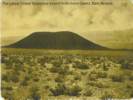 Eastern Mojave Vegetation
Eastern Mojave Vegetation
Tom Schweich
 Eastern Mojave Vegetation
Eastern Mojave Vegetation
| Nevada Highway 265 |
|
Tom Schweich |

Topics in this Article: Silver Peak |
(No Preface) | ||
|
Other articles:
|
Blair JunctionJunction:
| ||
|
Other articles:
|
To the northeast of "The Crater" and easily accessed from the road is "The Monocline." From a distance it appears to be sediments overlain by a basalt flow. I'm not sure what makes this a monocline, as I don't see flexure in the rocks. | ||
|
Other articles:
|
"The Crater" is a cinder cone just beside the road. | ||
 Postcard of The Crater near Blair, Nevada Postcard of The Crater near Blair, Nevada
|
Diane Bailey sent me this image of this postcard bearing an image of the Crater, which was sent by her great uncle Erle to his sister. | ||
|
Literature Cited:
Other articles:
Locations: Mineral Ridge. |
| ||
|
Locations: Blair. |
BlairBlair was developed by accident. Mining fever in the Tonopah boom reached out in all directions and revived many dormant mining towns. Land speculators at nearby Silver Peak bought up the land in that area and jacked the land prices so high that the 100-stamp mill planned at Silver Peak was built 1 ½ miles west of here to become the hub of Blair. The Pittsburg-Silver Peak Gold Mining Company built the 17 ½-mile Silver Peak Railroad running north in 1906 and the big mill (Nevada's largest in its day) in 1907. The remnants of stone buildings and mill foundations are the only remains of a once-thriving, but short-lived, mining town. By 1920, Blair was all but deserted (Nevada Historical Marker 174). | ||
|
Literature Cited:
Other articles:
Locations: Silver Peak. |
Silver Peak
Silver Peak is one of the oldest mining areas in Nevada. A 10-stamp mill was built in 1865, and by 1867 a 20-stamp mill was built. Mining camp lawlessness prevailed during the late sixties, and over the next 38 years, Silver Peak had its ups and downs. In 1906, the Pittsburg Silver Peak Gold Mining Company bought a group of properties, constructed the Silver Peak Railroad and built a 100- stamp mill at Blair the following year. The town, at times, was one of the leading camps of Nevada, but by 1917 it had all but disappeared. The town burned in 1948, and little happened until the Foote Mineral Company began its extraction of lithium from under the floor of Clayton Valley. Nevada Historical Marker 155. | ||
| If you have a question or a comment you may write to me at: tomas@schweich.com I sometimes post interesting questions in my FAQ, but I never disclose your full name or address. |
Date and time this article was prepared: 5/12/2025 2:57:36 PM |